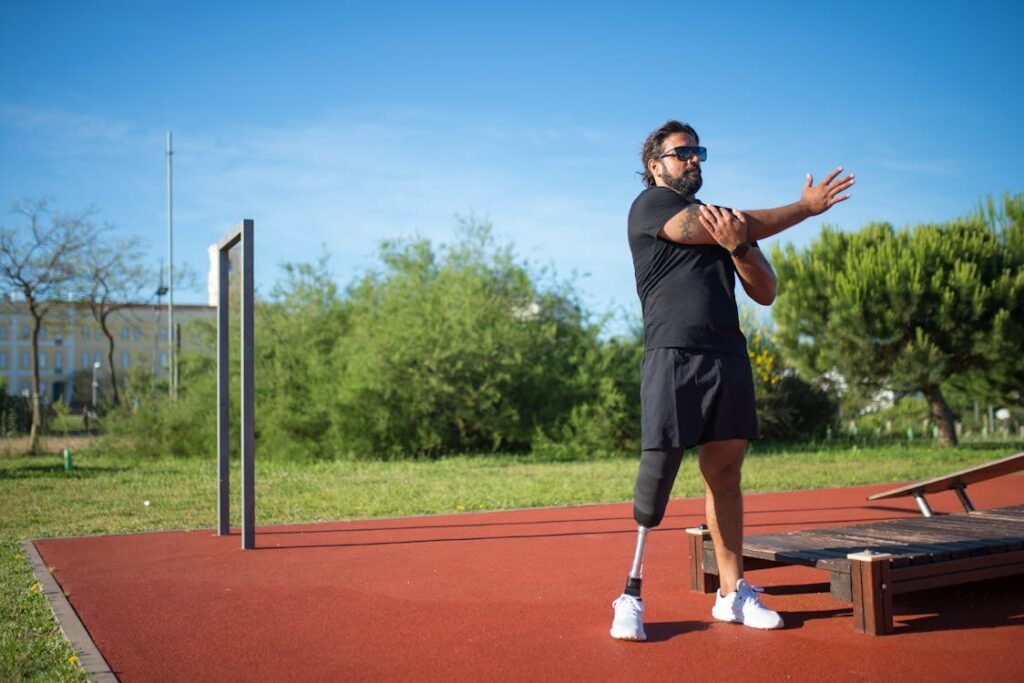Learning to walk again after a below-knee amputation is a journey filled with both challenges and small victories. One of the biggest factors that shapes this journey is something many people overlook at first—weight-bearing.
How your body handles weight, how that weight moves through your prosthesis, and how your residual limb supports it all makes a huge difference. It doesn’t just affect your walking speed or how tired you feel. It changes your entire sense of balance, your posture, and even your confidence while moving.
For below-knee amputees, understanding weight-bearing is more than a technical detail. It’s a key piece of the puzzle when rebuilding independence. And it often decides whether walking feels awkward—or smooth and natural.
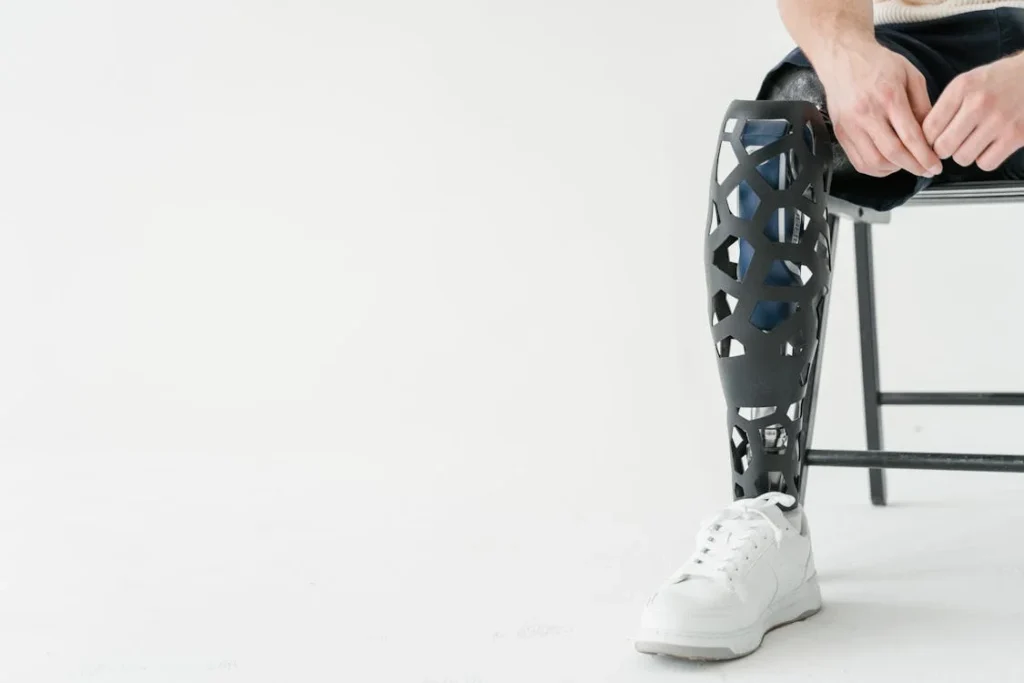
Understanding Weight-Bearing After a Below-Knee Amputation
After losing a lower limb, your body doesn’t just change physically—it changes in how it moves, balances, and responds to everyday tasks. One of the biggest shifts happens in how your body handles weight. This is what we call weight-bearing.
What Is Weight-Bearing?
Weight-bearing is how your body supports itself when you stand, walk, or move. In someone with two natural legs, weight is shared between the limbs in a fairly even way.
Each leg takes turns holding and shifting your body as you move. But in someone with a below-knee amputation, that balance is disrupted. Your body needs to learn a new way to support itself.
Your prosthesis becomes a new part of that support system. But your residual limb, the socket, and the rest of your body all need to work together to make it feel right.
When weight isn’t distributed well or when the load doesn’t move naturally through your prosthesis, it causes issues.
You may walk unevenly. You may feel off-balance. You may get tired faster or even develop pain in other parts of your body.
This is why weight-bearing isn’t just about standing up. It’s about how weight moves through you—how it flows from your hip down to your foot (or prosthetic foot), and how smoothly that process works.
The Challenge of Uneven Weight Distribution
After an amputation, your natural instinct is often to rely more on your sound leg. It feels safer. But over time, that habit can actually cause more harm than good.
When one leg is doing most of the work, your posture shifts. Your back compensates. Your hips work harder. And you start walking in a way that puts strain on your body.
The prosthetic side, meanwhile, may not carry enough of your weight. It might feel lighter, less stable, or even disconnected.
That lack of pressure can make it harder for your brain to trust the prosthesis. Without good weight-bearing, your gait becomes uneven, and balance becomes a struggle.
At Robobionics, we often see patients who’ve unconsciously trained themselves to “protect” their prosthetic side. The moment they shift that pattern—when they start bearing weight properly—everything begins to change. Their steps get smoother. Their fatigue reduces. And their confidence grows.
How Weight-Bearing Shapes Your Gait
Gait is simply the way you walk. It includes your stride, how your legs swing, how your body moves side to side, and how your feet hit the ground. For below-knee amputees, gait changes the moment weight-bearing changes.
If you don’t put enough weight on the prosthetic leg, you may take shorter steps with it. Or you might swing the sound leg faster to make up for lost time. These adjustments can make you limp or rock side-to-side. They also create a rhythm that doesn’t feel natural—and over time, your joints feel that extra stress.
On the other hand, if your prosthetic socket fits well and allows proper weight-bearing, your gait starts to feel more balanced. Your prosthetic leg moves with your body, not behind it. You’re not dragging or rushing. You’re just walking.
We’ve seen users go from hesitant, choppy steps to smooth, rhythmic walking just by working on how they bear weight. Sometimes, it’s not about changing the prosthetic itself—it’s about training your body to trust it again.
The Role of Socket Fit and Limb Alignment
Proper weight-bearing starts with the socket—the part of the prosthesis that connects to your residual limb. If it fits poorly, weight doesn’t get carried the right way.
You might feel pressure in some spots and nothing in others. That uneven pressure makes it hard to walk confidently.
A well-designed socket allows the weight to spread across your limb evenly. It helps you feel the ground and gives your muscles feedback with every step. At Robobionics, our team works closely with each user to shape the socket for their limb—not just in size, but in how it supports pressure.
Alignment matters, too. If the prosthesis isn’t aligned well with your body, your weight won’t flow naturally. It can feel like walking with one leg shorter or longer than the other.
Even a slight misalignment can change how much trust you put in the limb—and that affects balance more than you might think.
This is why the first few fittings matter so much. It’s not just about how it looks or how tightly it holds. It’s about how your body interacts with the prosthesis under load.
The Brain-Body Connection in Balance
Balance isn’t just physical. It’s also mental. Your brain uses constant feedback from your muscles and joints to keep you upright. When part of that system is replaced by a prosthesis, your brain has to learn a new pattern.
Weight-bearing tells your brain that your prosthetic leg is strong and reliable. It gives feedback with every step. Without that pressure, the brain stays uncertain. It hesitates. And you feel unsteady.
Training your brain to trust your prosthesis again takes time—but it starts with bearing weight properly. That’s where physical therapy and home-based rehabilitation come in.
Simple, repetitive movements help rebuild that brain-body link. Over time, your steps become more automatic. You stop thinking about walking and just walk.
At Robobionics, we use gamified rehabilitation to make this process smoother. Through small daily activities, users learn to shift weight correctly, improve posture, and build muscle memory—without even realizing how much they’re improving.
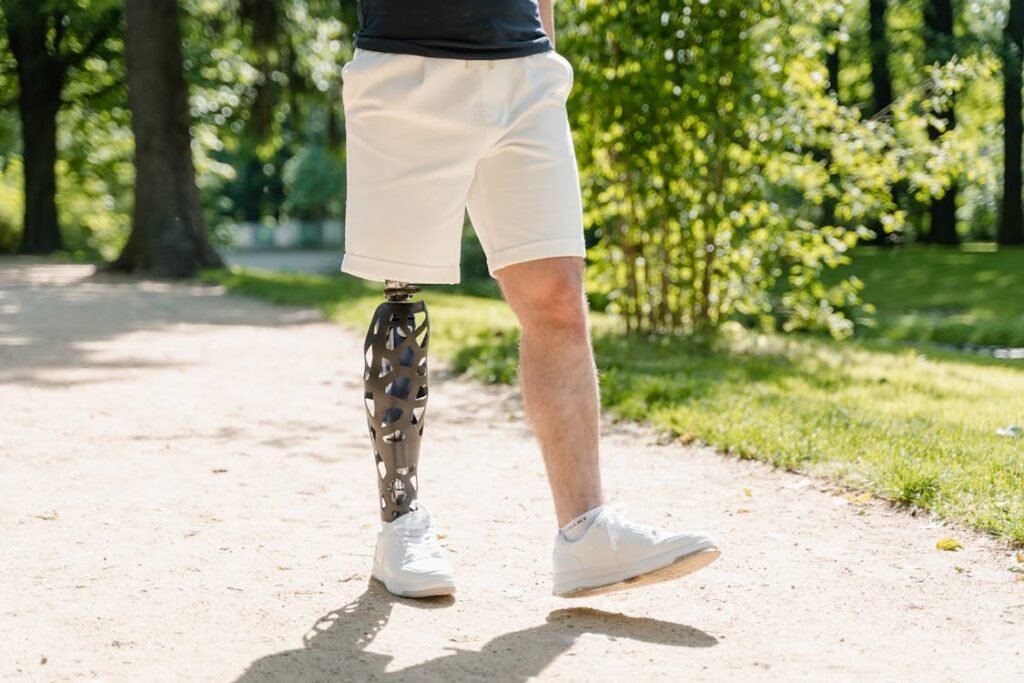
How Improper Weight-Bearing Affects Balance and Posture
After a below-knee amputation, balance becomes one of the first noticeable challenges. It’s not just about standing still without falling.
It’s about feeling steady when you move, turn, climb, or even sit down. A lot of that control comes from how you bear weight through your prosthetic side.
Why Balance Feels Off After Amputation
When one of your legs is replaced with a prosthesis, the way your body senses movement and position changes. Your natural leg sends signals to your brain through nerves, muscles, and joints.
Your prosthetic leg can’t do that on its own. Instead, it relies on how well your body connects to the socket and how much pressure you apply through it.
If you don’t bear enough weight on the prosthetic side, your body becomes uneven. You start leaning more on your sound leg.
That might feel safer at first, but it throws your balance off. Over time, you might even change how you use your arms or your spine to stay upright, which leads to extra strain and more fatigue.
Balance isn’t just about not falling. It’s about feeling in control while you move. And that’s only possible when the body learns to share weight evenly again.
Postural Changes and Their Impact
Improper weight-bearing leads to noticeable changes in your posture. You may not realize it at first, but your shoulders might start tilting. Your hips might shift. One side of your back could become tighter than the other.
These small adjustments add up. You might start walking with a slight lean. You could find yourself overusing your good leg, which might cause pain in the knee or hip.
And your core muscles may weaken over time, since they’re not being used in balance the way they used to be.
We often see people walk into our clinics not because of socket discomfort, but because they’ve developed secondary issues like back pain or muscle tightness. I
n most cases, the root problem goes back to poor weight-bearing and unbalanced movement.
The good news is that this can be fixed. With the right guidance and consistent practice, your body can relearn better posture and weight distribution—even if it’s been months or years since your amputation.
Learning to Shift Weight Confidently
One of the key parts of prosthetic rehabilitation is retraining how you shift weight from one leg to the other. Early on, this can feel scary.
You may feel like your prosthetic side isn’t strong enough. But learning to trust that side is what allows you to walk smoothly and stand with better posture.
Physical therapy often starts with simple side-to-side weight shifts while standing. You learn to feel when your weight is on the prosthesis and when it’s not. With time, you’ll start taking steps, turning, and climbing stairs with more confidence.
This process is especially important for balance. When you’re able to shift your weight fluidly, you can adjust to uneven ground, sudden movements, or small stumbles. That’s what keeps you safe—and helps you feel stable in daily life.
At Robobionics, we’ve seen how even a few minutes of focused weight-shifting practice each day can make a big difference. Combined with a well-fit socket and good alignment, these small exercises create big results.
The Importance of Muscle Strength in Weight-Bearing
Weight-bearing isn’t only about the prosthesis. Your muscles need to be strong enough to support you as you shift weight and move. After an amputation, some muscle groups get used less, while others work too hard.
For example, if your glutes and thighs aren’t strong, you’ll have trouble pushing off with your prosthetic side. If your core muscles are weak, your posture will suffer.
And if your ankle or knee muscles on the sound side are overused, they’ll get tired faster and might even get injured.
That’s why strengthening your body is part of learning proper weight-bearing. The stronger you are, the easier it becomes to balance and walk with confidence.
And the more balanced your muscles are, the less strain you put on any one part of your body.
Our gamified rehab programs are designed with this in mind. They help build strength while keeping you engaged and motivated. You’re not just doing exercises—you’re playing your way to better control.
Emotional Effects of Poor Balance
It’s not just physical. Poor balance can also take a toll on your emotions. Many people with below-knee amputations feel nervous when walking outside, going up stairs, or even standing in crowds. They fear falling or looking unstable.
This fear often leads to avoidance. People stop going to social events. They rely too much on support. And their world slowly becomes smaller. All of this starts with a lack of confidence in their balance.
Once you start bearing weight properly and feel more in control of your movements, that fear begins to fade. You start saying yes to more things.
You take longer walks. You climb stairs without thinking twice. And you stop worrying about every little movement.
That’s the power of proper weight-bearing. It doesn’t just change how you move—it changes how you feel about moving.
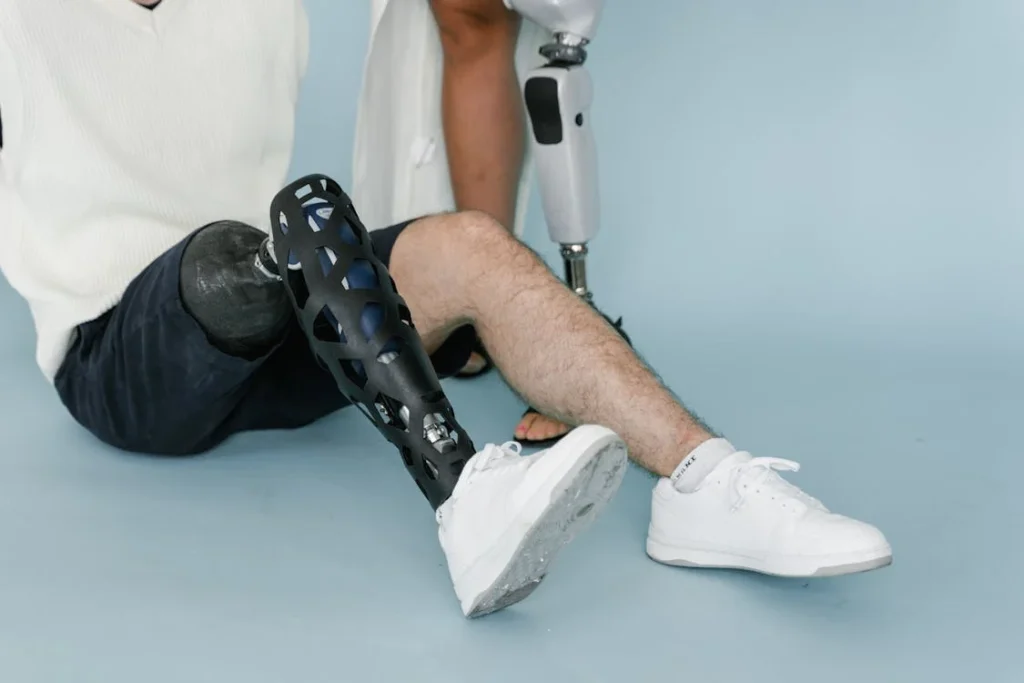
The Role of Prosthetic Design in Supporting Weight-Bearing
While learning to bear weight properly is partly about training and confidence, the design of your prosthetic limb plays a huge role too.
Even with strong muscles and determination, if the prosthesis doesn’t support your weight the right way, it becomes harder to walk smoothly and stay balanced.
The Foundation: A Well-Fitting Socket
The socket is where everything begins. It’s the part that connects your residual limb to the rest of the prosthesis. If it doesn’t fit well, your weight won’t be distributed properly.
You might feel pressure on one small area instead of evenly across your limb. That leads to discomfort, instability, and eventually avoidance—you stop putting full weight on that side because it doesn’t feel right.
A total surface-bearing socket, when done well, spreads your weight across your entire limb. That even contact helps your brain and body trust the prosthesis more.
It also prevents skin problems and soreness, which are common reasons people stop using their prosthetic for long hours.
At Robobionics, we use detailed limb assessments and precision 3D printing to make sockets that match your body exactly. This means fewer pressure points, better comfort, and more freedom to bear weight confidently.
Suspension Systems and Stability
Another important factor in prosthetic design is how the limb stays attached to your body. This is called the suspension system. If your prosthesis slips, shifts, or feels loose while walking, it can create insecurity.
That insecurity leads to bad habits—like keeping too much weight on the sound leg or leaning to one side.
There are several types of suspension systems: suction, pin-lock, vacuum-assisted, and others. Each has a different way of keeping the limb in place. The key is finding the one that feels most secure to you.
When the limb is stable and moves with your body, you’ll find it easier to step fully onto it, shift your weight, and balance better.
This might seem like a small detail, but it’s one of the most common reasons users either thrive or struggle with their prosthesis.
We always focus on choosing the right suspension based on your daily life—whether you walk short distances or lead a very active lifestyle. A good suspension system doesn’t just hold your limb—it gives you the confidence to use it fully.
The Prosthetic Foot’s Role in Weight Transfer
The prosthetic foot also plays a big part in how you bear weight and walk. If the foot doesn’t respond well to pressure, it can throw off your balance.
Some feet are stiff and only work for simple walking. Others are dynamic, with flexible heels and toes that respond to movement.
When you step onto your prosthetic foot, you want it to absorb weight and then return energy to help you step forward. This is called energy return. It helps reduce the effort needed to walk and makes the gait cycle more natural.
A foot that doesn’t allow proper roll-over can make you stop mid-step or throw your weight backward. This delays your movement and makes walking feel jerky.
Over time, you stop trusting that side, and your weight-bearing habits suffer.
At Robobionics, we fit each prosthesis with a foot that matches the person’s activity level. For some, that’s a basic solid ankle foot.
For others, especially those who walk long distances, it may be a lightweight foot with a split toe and better ground adaptation.
When your foot works well with your socket and suspension, it allows you to move in one smooth, confident line.
That’s what supports balance—not just on level ground, but when you’re going uphill, stepping onto a curb, or walking across uneven paths.
Alignment and the Walking Pattern
Alignment is how your prosthetic components are positioned in relation to your body. If the socket is too far back, the foot is too far forward, or the angle is off, your weight won’t flow through the limb naturally.
This throws off your gait and balance, no matter how good the parts are.
A well-aligned prosthesis makes weight transfer feel automatic. You don’t have to think about each step. You don’t have to stop and reset your posture. Your body simply moves.
We fine-tune alignment during your fitting sessions by watching how you walk, testing balance points, and using digital tools when needed. Sometimes even a few degrees of change can shift your entire walking pattern for the better.
This kind of adjustment often surprises users. They’ve been living with discomfort for weeks or months, thinking it’s normal.
But once the alignment is corrected, they immediately feel the difference—and realize how much easier movement can be.
How Prosthetic Fit Affects Daily Confidence
The way your prosthesis fits and supports weight has a direct link to your daily mood and mindset. When things fit well and move naturally, you don’t have to focus on walking. You can focus on your day.
You can carry groceries, walk across wet floors, climb steps at work, or stand in line at the bank—without worrying that your balance might slip or that your leg might shift.
That sense of freedom is often taken for granted until it’s gone.
When weight-bearing becomes second nature, your confidence grows. You stop looking down at your feet every few seconds.
You start looking up. You make eye contact. You feel present in the moment, not distracted by every small adjustment in your step.
That’s why we always say: your prosthesis shouldn’t just be wearable—it should be forgettable. Not because you ignore it, but because it works so well that you don’t have to think about it all the time.
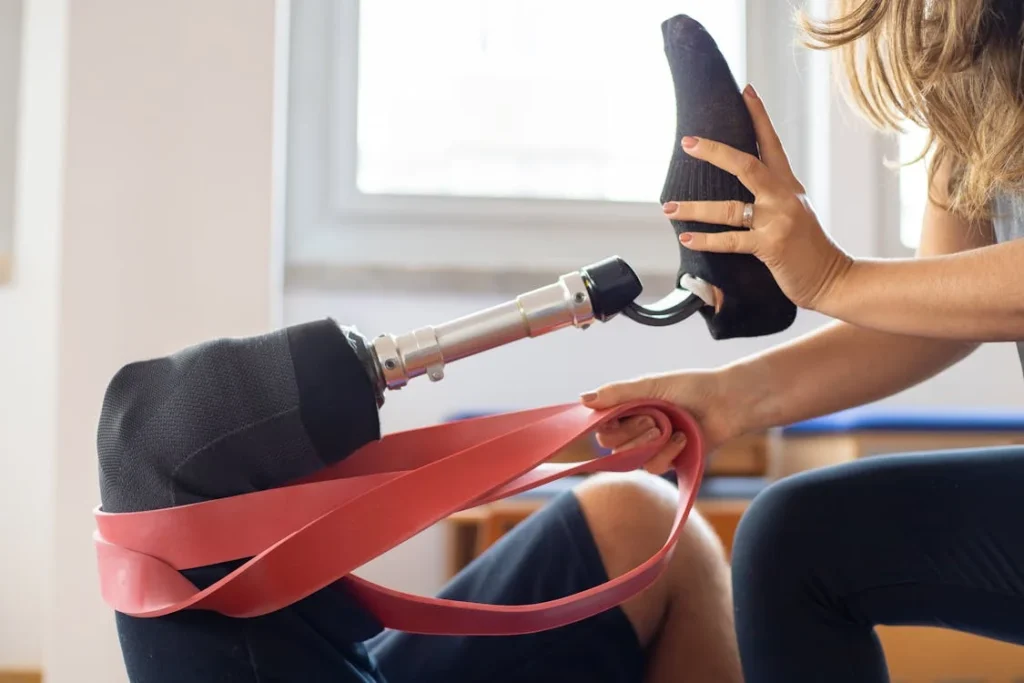
Training the Body and Mind for Better Weight-Bearing
Getting the right prosthesis is just the beginning. Learning how to use it—how to trust it—is what truly shapes your gait, balance, and independence.
For below-knee amputees, one of the most important steps after fitting is training your body and mind to bear weight correctly. This isn’t just about physical therapy. It’s about building new habits, restoring body awareness, and developing confidence from the ground up.
Starting Slow, Building Trust
When you first begin using your prosthesis, it’s normal to feel unsure. Your body naturally wants to protect itself, especially after surgery, pain, or a long healing period. That’s why many users instinctively avoid putting full weight on their prosthetic side.
But that habit, if left unchecked, can become a barrier to progress. Over time, avoiding weight-bearing leads to an uneven walk, poor balance, and greater fatigue. The trick is to slowly reintroduce weight on the prosthetic side in a way that feels safe.
This usually begins with standing exercises. You might be asked to shift weight from one leg to the other while holding on to parallel bars or a walker.
At first, it may feel strange. But with repetition, your body starts to remember what it means to stand tall and balanced.
Each session builds trust—not just in the device, but in your own ability to support yourself again.
Muscle Memory and Repetition
Your body relies heavily on muscle memory. Before your amputation, you didn’t think about walking—you just did it. But after surgery, those patterns are disrupted. Muscles, joints, and nerves that once worked together need to learn new ways to move.
Repetition is how we rebuild those patterns. Every time you step onto your prosthetic side, your brain receives feedback.
Over time, that feedback becomes smoother and more automatic. This is why even small, simple movements—like stepping side-to-side or practicing weight shifts—are powerful.
They don’t just improve balance. They teach your brain that the prosthetic side is reliable, capable, and part of your movement system again.
Gamified rehab tools, like the ones used by Robobionics, are great for this. They make repetition fun, engaging, and goal-oriented.
Instead of just counting steps, you’re completing small challenges or games that reward you for proper form and progress. That keeps you motivated and moving forward.
Balance Training and Core Stability
True balance doesn’t come from your legs alone. It comes from your core—your hips, your back, your abdominal muscles. These muscles stabilize your body and allow you to move in every direction without tipping over.
After a below-knee amputation, the core can become underused. Because you’re focusing so much on your legs, you may forget to engage your midsection.
This leads to poor posture and less control over your body, especially when doing things like turning quickly, reaching, or bending.
That’s why core exercises are a key part of weight-bearing rehab. They might include sitting on a therapy ball, standing on soft surfaces, or using small weights to challenge your balance.
These activities teach your body to react, adjust, and stay centered—even when you’re on uneven ground or in motion.
The stronger your core becomes, the easier it is to stay upright, bear weight evenly, and move confidently with your prosthesis.
Walking with Rhythm and Flow
Gait training is another part of learning better weight-bearing. Early steps are often stiff, hesitant, or rushed. You may swing your good leg too far or cut your stride short on the prosthetic side.
These are natural habits that come from trying to protect yourself.
But to walk smoothly, you need rhythm and flow. Your steps should be even, balanced, and continuous. That only happens when your body fully trusts the prosthesis to carry your weight.
A physical therapist will often work with you to fine-tune your stride. They might use mirrors, video recordings, or even sensors to help you see how your body moves.
This visual feedback helps you adjust in real-time and make your movements more natural.
And once you get that rhythm down, everything becomes easier—from walking to the kitchen, to stepping off a curb, to dancing at a family event.
Tackling Fear and Building Confidence
For many people, the fear of falling is bigger than the fall itself. That fear can quietly shape your decisions—how far you walk, where you go, and how independent you feel.
And often, it’s directly tied to how confident you are in your weight-bearing and balance.
The only real way to overcome this fear is through practice. By starting in safe, controlled spaces and gradually adding new challenges, you begin to replace fear with trust.
First, it’s walking across your living room. Then it’s a walk around your neighborhood. Eventually, you’re climbing stairs, walking on gravel, or stepping into a crowded room without hesitation.
Every small success builds confidence. And every time you bear full weight without issue, that fear becomes smaller.
At Robobionics, we often remind users that progress doesn’t always look big. Sometimes it’s just being able to stand without reaching for support.
Or putting full weight on your prosthetic side without shifting away. These quiet victories are the building blocks of long-term success.
Staying Consistent Over Time
Consistency is what keeps your progress from slipping backward. Just like any other skill, weight-bearing and balance need maintenance.
That means keeping up with basic movements, staying active, and doing occasional check-ins with your prosthetist to ensure your socket and alignment still support your goals.
Even if you feel stable and strong today, regular movement helps your body stay adaptable. Life changes—your weight might shift, your activity levels may rise or fall, and your limb might change shape slightly.
Staying in tune with your body helps you catch small problems early, before they grow into setbacks.
We encourage users to treat rehab not as a one-time event, but as a lifelong habit. Just a few minutes each day keeps your muscles sharp, your coordination smooth, and your confidence high.
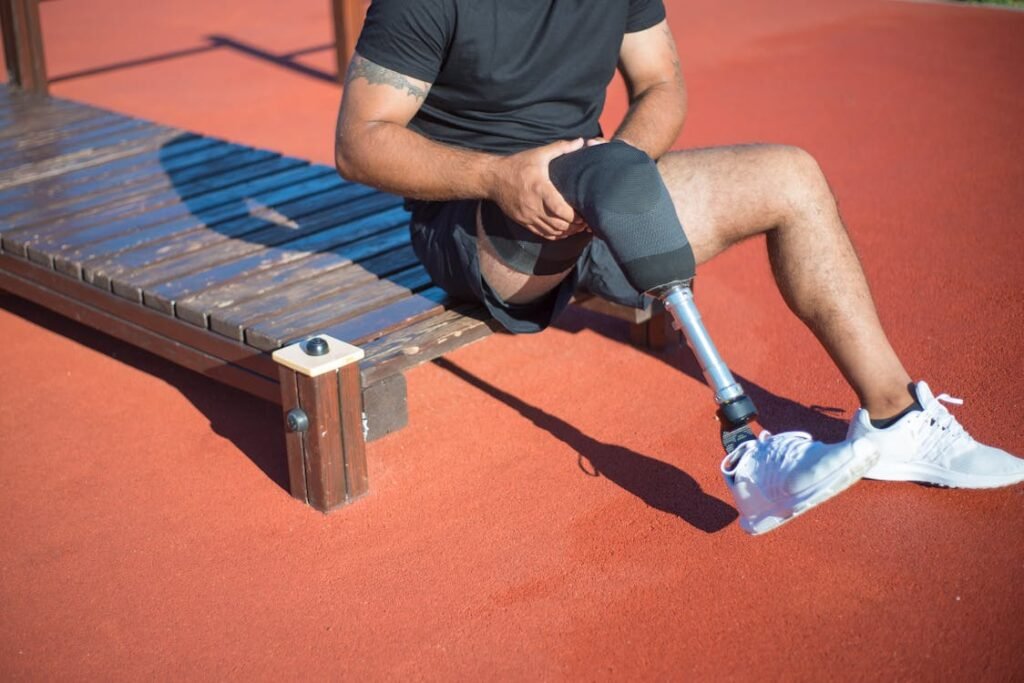
How the Brain Rewires for Weight-Bearing and Balance After Amputation
After a below-knee amputation, the body doesn’t just change on the outside. Inside your brain, a complex process begins—a quiet but powerful transformation that helps you adapt, balance, and move again.
This change is known as neuroplasticity. It’s how your brain rewires itself to include your prosthetic limb in the way it processes movement, pressure, and body position.
Losing a Limb Doesn’t Mean Losing Brain Connections
Every part of your body has a matching area in the brain that controls movement and sensation. After an amputation, the brain doesn’t erase the area linked to your missing limb. Instead, that area becomes less active—but it doesn’t go away.
When you start using a prosthesis, your brain begins to make new connections. It starts associating your residual limb and prosthetic with familiar actions like walking, standing, and balancing.
The more you use the prosthesis, the stronger these new connections get.
This is part of why early use and consistent weight-bearing matter so much. The brain needs repetition to build and reinforce these new patterns.
The more often you shift your weight onto the prosthesis, the more your brain accepts it as a part of your body’s normal function.
This process is what allows someone to go from walking stiffly to moving fluidly over time—not just because their muscles improve, but because their brain starts working with the limb instead of treating it like something foreign.
Phantom Limb Sensations and the Weight-Bearing Connection
Many below-knee amputees experience phantom limb sensations—feeling like the missing foot or toes are still there. Sometimes, this sensation is mild. Other times, it’s painful or distracting.
Interestingly, studies and clinical experiences show that consistent and correct weight-bearing through a prosthesis can reduce these sensations.
Here’s why: the brain gets feedback from the prosthesis when weight is applied through the socket. That feedback is similar to the pressure it used to get from the foot.
This input helps calm the brain and reduce the confusion that causes phantom pain or weird sensations.
So, when a prosthetic is fitted properly and weight-bearing is practiced regularly, it may actually help soothe the brain and create a clearer internal map of your body.
That leads to better control, better balance—and in many cases—less phantom discomfort.
Rebuilding Proprioception Without a Foot
Proprioception is your body’s ability to sense where it is in space. You know when your foot is on the ground even if you’re not looking at it.
You know if your leg is bent, or straight, or turning. That sense comes from receptors in your muscles, joints, and skin.
After amputation, a large part of that sensory system is lost. But it’s not gone forever.
Your body can rebuild proprioception by relying on the residual limb, pressure feedback from the socket, and visual cues.
When you begin to bear weight evenly and consistently on your prosthetic leg, your brain gets clearer information about where you are in space. That improves balance.
You might notice this change gradually. In the beginning, you may feel unsure of each step unless you look down. But over time, you’ll notice your head stays up more.
You start to “feel” the ground again, even though your biological foot is no longer there.
This restored sense of body awareness doesn’t come automatically. It’s built through repetition, physical therapy, and daily movement.
That’s why proper gait training, socket fit, and home rehab are so important. They don’t just change your muscles—they retrain your brain.
Emotional Relief Through Neurological Control
When your brain starts to recognize and trust your prosthetic limb, something deeper happens. You begin to feel calmer. More in control. More present.
There’s a link between physical balance and emotional well-being. When your brain doesn’t feel stable in your body, anxiety can increase.
But as proprioception improves and weight-bearing becomes second nature, you start to feel safe again in your own skin.
This emotional shift is something we see often in our clinics. A user who was once tense and cautious begins to smile more. They talk with more energy. They start making plans again.
That change doesn’t come from a motivational speech. It comes from moving freely, standing tall, and knowing your body is working with you again—not against you.
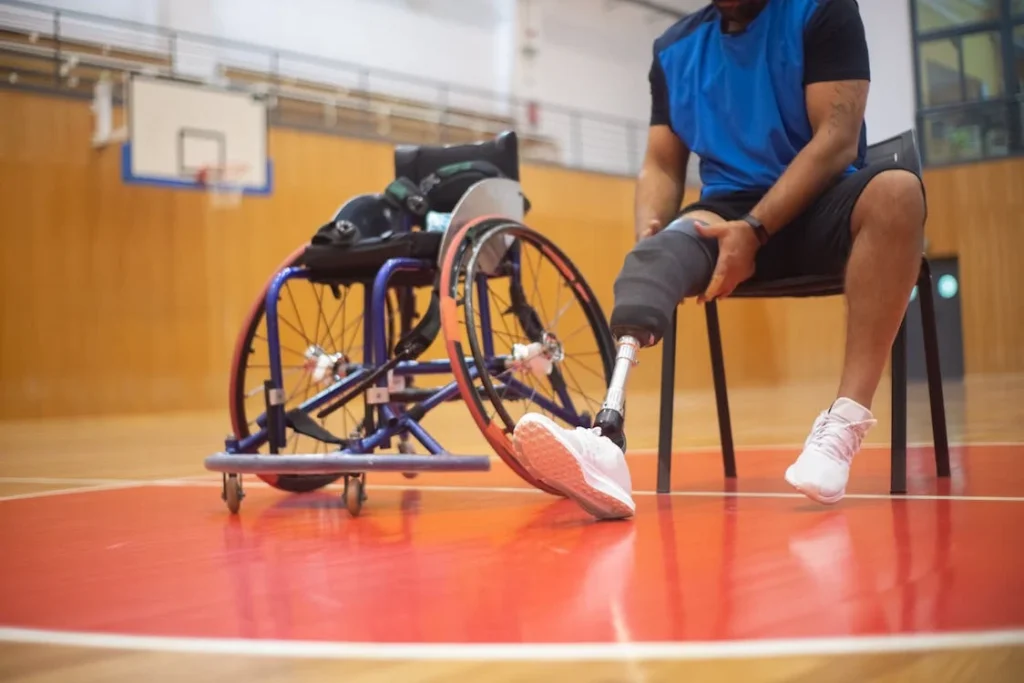
From Awareness to Acceptance: The Mind-Body Shift in Recovery
Regaining movement after a below-knee amputation is not just a physical milestone—it’s a deep mental transformation. The journey of weight-bearing starts with the body, but the real success is when the mind and body begin to work as one again.
Turning Effort Into Instinct
In the early stages, every step takes effort. You think about foot placement, you glance at the ground, and you consciously shift your weight. But as your brain adjusts, what once felt mechanical becomes instinct.
This is the point when users stop walking with hesitation. They stop calculating every step. They start moving through life again.
That shift isn’t about brute strength or speed. It’s about the brain finally accepting the prosthetic limb as a trusted tool, almost like a part of your natural body.
You begin to move because you feel how to move—not because you remember instructions or try to force it.
At Robobionics, we’ve seen users reach this stage gradually. One day they realize they walked across a room without thinking about it.
Or that they caught their balance after tripping, just like they used to. That moment is quiet, but it’s incredibly powerful.
Emotional Clarity Through Movement
Movement and emotion are tightly linked. When your body feels awkward, unstable, or unsafe, it feeds emotional tension. Anxiety rises. Y
our world feels uncertain. You pull back from daily life—not because you want to, but because it feels easier to avoid challenge.
But when your body feels stable, your mind opens up again. You feel stronger, calmer, and more prepared to face the world.
This kind of emotional recovery happens step by step, through every small win—bearing weight fully for the first time, walking without a limp, standing tall in front of a mirror.
It’s why proper rehabilitation, socket design, and gait training are about so much more than physical results. They bring peace. They return a sense of control. They let people feel whole again.
We’ve seen users tear up—not because they’re in pain, but because for the first time in months, they felt normal. That’s what a stable, confident, weight-bearing gait gives you. It’s not just function—it’s freedom.
Trust: The Final Layer of Recovery
In the end, weight-bearing isn’t just about how you move—it’s about how much you trust yourself to move. It’s about believing your prosthetic leg will hold you up, that your brain knows what to do, and that your body will keep you steady.
That trust is the real victory. It doesn’t happen overnight. It’s built slowly, patiently, with the help of good prosthetic care, consistent therapy, and gentle encouragement from those around you.
At Robobionics, we design every socket, every program, and every piece of support with this final goal in mind—not just to help people walk, but to help them trust again.
Because when your body and brain move in sync, and when your steps carry you forward without fear, you don’t just recover—you come back stronger.
Conclusion
Weight-bearing after a below-knee amputation isn’t just a technical step in recovery—it’s the foundation for movement, balance, and confidence. From how your socket fits to how your brain rewires itself, every part of your body plays a role in learning to walk again with stability and ease.
When done right, proper weight-bearing restores more than just mobility. It helps you feel secure, upright, and in control. It reduces strain, builds muscle memory, and encourages your brain to accept the prosthesis as part of you—not just a tool you wear.
The journey takes time, but with the right guidance, socket design, and training, you move from caution to confidence—one step at a time. At Robobionics, we’re here to walk that path with you.
Because true recovery doesn’t end when you get a prosthesis. It begins when you start trusting it—and yourself.



